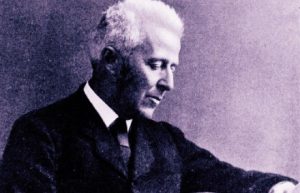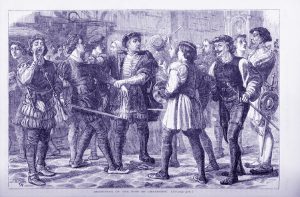
How much of history can we trust? Asking that question can cause trouble, because if we question established history too hard, it unravels. We can accept nothing and must question the motives and sources for everything established as fact. In doing that, we find the “facts” are less factual than we thought. History is defined not by reality, but by the perceptions and biases of those who recorded it.
This is never truer than with Mary Tudor. Though her sister and father had many more executions during their reigns, it’s her history labeled with the monicker of “Bloody.” Her father’s death toll estimates at 74,000, including cousins, wives, trusted advisors, politicians, friends, governesses to the royal children, and clergy. A large portion of that number comes from the Pilgrimage of Grace, where loyal Catholic subjects rebelled against the oppressive new Reformist regimes that destroyed their churches and forbid them from practicing their faith. Henry VIII is the true “bloody” tyrant, but Mary is given the title for the 284 Reformists burned at the stake during her reign, if you go by the numbers in The Book of Martyrs first published in 1563.
The author, John Foxe, was a Reformist; his intention was to draw attention to the lives of the martyrs and discredit and vilify Catholics. Puritans widely read the book, which helped mold public opinion in negative ways toward Catholic monarchs. During Elizabeth’s reign, her advisers saw this as helpful in dissuading the public from trying to place a Catholic usurper (Mary Queen of Scots) on the throne. The stories were reinforced over time, while Reformist historians swept the bloody, barbaric actions of Reformist monarchs under the rug. What better way to stay in power than define the opposition as a tyrant?
Mary’s reputation started with a bias, continued with an agenda, and despite its questionable and biased origins, is still propagated as fact, which means we must ask the why? What purpose, other than continued prejudice against her faith, causes us to care more about those martyred under her reign than those that died under any other British monarch in history? All we know about Mary’s reign and how the populace responded is propaganda; we can’t trust it.
Doubts about the reliability of Foxe’s statistics are based in the statements he produces as “facts” refuted by his contemporaries (certain nasty stories about Sir Thomas More are based in slander from the period, and More himself refuted them violently, denying he tortured people for information; he put them in the stocks, but did not “flog Reformists” in his garden; he had a man flogged for flipping women’s skirts up over their heads during Church prayers). Fox is unreliable, but a defense was made for him in the 1930s by Historian J.F. Mozley, who doubted one could “invent” the stories in The Book of Martyrs. Considering his agenda (he was openly, unapologetically biased toward the Reformists), can we trust him to have researched this without a foregone conclusion?
The Stripping of the Altars: Traditional Religion in England, 1400-1580 by Eamon Duffy mostly focuses on the beliefs of the period, but contains a whole chapter on Mary, challenging our ideas of her reign. It asserts that England did not yield to Reform; the populace saw Henry’s break from the Catholic Church as a means of obtaining a divorce from their beloved queen. When her daughter Mary took the throne, despite her assertion that she would not outlaw Lutheranism, many churches voluntarily reinstated their Latin Mass and original prayer books and teachings, to public satisfaction, because the populace never abandoned their traditional roots. The Marian regime came up with a long-term plan to gradually reinstate Catholicism and incorporate Reform in the publication of an English Bible and new liturgies.
Duffy states that the burnings, while deplorable, were “accomplishing what the Marian regime” intended to do: bring order. The fires were “slacking off” toward the end of her reign and may have soon ceased. They were also motivated more to quell religious rebellion than out of anti-Protestantism. By burning people, the regime hoped it would dissuade others from joining a cause to overthrow Mary and place a Protestant on the throne. This does not justify the actions of her government, but it raises the question of if Mary had not died young, whether history would have seen her in a far different light once she reformed the Church and brought England into a time of property and peace. (Her policies and financial decisions laid the groundwork for her sister’s rich reign.)
In Foxe’s Reformist eyes, Mary was a loathed Papist murderer. His prejudices have carried on into modern times, reinforced by ongoing distrust and hatred for Catholics generated during the English Reformation. In Duffy’s eyes, as a self-confessed “cradle Catholic,” she is neither saint nor monster, but overshadowed by the burnings of the period, which prejudice the reader and make them less inclined to see her as a well-intentioned but misguided advocate for a different brand of religious reform in England that, had it been allowed to continue, might have been successful. Both men are biased, but together they present a complex woman about whom, tragically, the entire truth will never be known.
Reformist influences in England and, by extension, in the United States, have gone a long way in the unfair vilification of Mary; her representation as a brutal and unpopular ruler during her reign (instead of cast that way after her death) is reinforced by cultural depictions of Mary that show her in a negative light while casting Elizabeth in a favorable one. We cannot be certain the people of her England did not support her policies. Much emphasis is placed on Elizabeth’s virtues, reminding us of her long, prosperous, popular reign, her feminist ideals, and her victories against the Spanish Armada, while showing us a nation terrorized by the Catholic Mary, who burns “heretics” every day and “sleeps with a sword under her pillow,” she is so afraid of the populace that despises her. Bias toward Elizabeth is also reflected in the greater emphasis on her parents over Mary’s, and how their mothers are portrayed.
The “love affair” of Henry and Anne Boleyn has been told many times, and with only a few exceptions, the story begins when Anne catches his eye. She is young, pretty, opinionated, and feisty; his Catholic wife, Catherine of Aragon, is dowdy, boring and old, and he had to marry her against his will. In truth, Catherine was immensely popular, wore a constant smile, and kept the company of the period’s greatest intellectuals. Though devout, she loved art, literature, and music; her court was known for dancing, pageants, and entertainment. Her love story with Henry is as romantic and tragic as that of Henry and Anne Boleyn… so why has it never entirely been told outside of my novels and a handful of others?
Favoritism toward Elizabeth, her mother, and Reform, and bias against Mary, her mother, and Catholicism is obvious… my question is, now we are aware of it, when will it end?
Intrigued by the politics and passions behind the Tudor dynasty? Explore the hidden truths of the early Tudors in my historical fiction series, The Tudor Throne.





